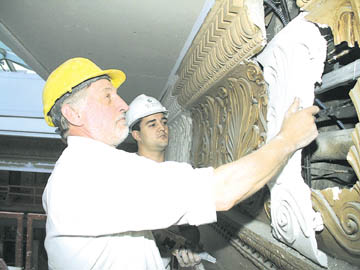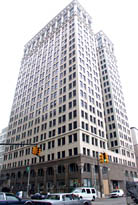'Original grandeur' the goal for Griswold Place renovation
Date Posted: August 31 2001
One of Detroit's oldest skyscrapers, the 23-story Griswold Place, is undergoing a renovation that will completely modernize its innards while maintaining the unique character of a landmark building.
It's a blending of the new and the old, and one of the most conspicuous examples is the ornate plaster work that's being preserved in the building's lobby. But there are numerous other examples, including complete replacement of the building's 1,867 windows, replacement of most of the mechanical systems including a new electrical substation, new elevator equipment and a new sprinkler system.
"This isn't an update," said Jerry McKindles, vice president and CEO of the BOSC Group, the developer and property manager. "It's a replacement. We are building a new building in an old building shell."
Parliament and Sachse Construction are acting as construction manager on the $37 million project.
A recent article in CAM (Construction Association of Michigan) Magazine featured the building's renovation. Griswold Place, at Griswold and Fort streets, was one of Detroit's first skyscrapers. Built in 1913, work on the 390,000 square-foot building today "ranks as one of the most extensive renovations of an historic structure in Detroit," the magazine said. It was one of the last buildings to be designed by famed Chicago architect Daniel Burnham, the father of the modern skyscraper.
In the past, the building has been known as the Dime Savings Bank and One Kennedy Square. It sits across from the site of what will be the new Compuware headquarters.
Split in the middle to allow for extra light in inner offices through a "light court," the building's signature feature is the large skylight above the three-story lobby, which is being restored to its original beauty. Below the skylight is some nice old ornamental plaster work - the kind that almost never gets called for today in a drywall world.
"It's nice to see them saving the work in the old atrium," said foreman Robert Plotzke of Plasterers Local 67, who worked on the project for three months this summer, with a crew of six from Russell Plastering. "I enjoy working with the ornamental plaster, but if you ask any plasterer, they'll tell you they like working with the old stuff. Working on a flat wall, you don't get the same sense of accomplishment that you do with this stuff. This is a real nice ornamental job."
A fair portion of the Griswold Place's plaster in the atrium had experienced water damage, which had gone unnoticed because a grid ceiling was covering it up. The plasterers created molds to match the old ornamental work, and replaced the damaged plaster.
"It's a pretty cool job," said James Belanger, a 4th-year plasterer apprentice. "We're used to working on flat walls, so it's a little more interesting to do this stuff and it involves more craftsmanship. I'm really happy with how it turned out."
The building, mostly empty, is being transformed into Class A office space. In stripping the structure, the trades are working around and through a skyscraper that was typical for the early part of the century: it was overbuilt. Floors are 20-inch thick concrete, while today's are five-to-six inches thick. It was necessary - and no small task - to create three major holes on every floor in order to accommodate sprinklers, wiring, and other mechanical equipment.
"It's a very nice, interesting building with a lot of original, ornate materials," said Charlie McFarlin, project superintendent for Sachse, who said completion is set for the end of the year. "The customer is going to get a completely modern building, set up with new mechanical equipment, fiber optics, everything. It will be nice to restore this building to its original grandeur."

PLASTERER Robert Plotzke and apprentice James Belanger of Local 67 and Russell Plastering dry-fit a restored section of ornamental plaster in the upper reaches of the Griswold Place lobby.

BUILT IN 1913, the Griswold Place skyscraper at Fort and Griswold streets is being stripped to its shell during a $37 million modernization project.
